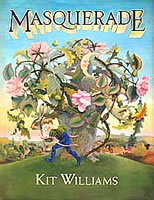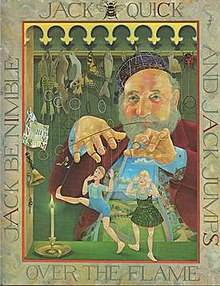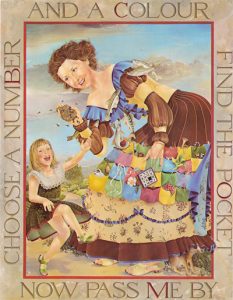 Masquerade is an illustrated storybook created by Kit Williams and was published in 1979. The book included an armchair treasure hunt and is often said to be the forerunner for treasure hunts of its kind. For instance, numerous books, like the current armchair treasure hunt Fandango, have since followed and were inspired by Masquerade’s release; they contain clues for finding a hidden treasure.
Masquerade is an illustrated storybook created by Kit Williams and was published in 1979. The book included an armchair treasure hunt and is often said to be the forerunner for treasure hunts of its kind. For instance, numerous books, like the current armchair treasure hunt Fandango, have since followed and were inspired by Masquerade’s release; they contain clues for finding a hidden treasure.
The book Masquerade can still be enjoyed as a children’s tale all on its own, but included within its text and images were hidden clues for finding a real buried treasure (since found). The buried Prize was a Jeweled Golden Hare valued at around £5000. The treasure related to William’s story about the Moon falling in love with the Sun and how the Moon asked Jack Hare to deliver a gift to the Sun. This gift, however, during Jack’s travels, was lost. Where this gift was lost is where searchers would find the real treasure.
The Masquerade hunt involved reading the story, looking at the illustrations, and determining clues which would instruct a searcher for where the Golden Hare was buried. The hunt ended in a bit of a scandal about two years later when Ken Thomas (real name Dugald Thompson) unearthed the casket containing the Jeweled Hare by NOT successfully solving the ‘puzzle within the book’, but allegedly by gaining connections and extra information for where it was hidden through Kit Williams and his ex-girlfriend.
Mike Barker and John Rousseau had, however, actually solved the location for the Jeweled Hare the way it was intended almost at the same time ‘Thomas’ lay claim to it. It is unfortunate these two physic teachers didn’t come away with the treasure, but they are credited today with discovering the true solution first.

The Solution for Masquerade began with realizing the method used to find a hidden Riddle. This Riddle, once understood, would then lead a searcher straight to the Treasure’s exact location.
Clues in the book hinted on how to find the Riddle. One of the main clues was a line on the opening page which stated, “To solve the hidden riddle, you must use your eyes, and find the hare in every picture that may point you to the prize.”
With the help of a numbered magic square on one page (Penny Pocket page), and matching the numbers to a colored square grid on another page (Isaac Newton page), searchers were able to deduce a sequence on how to draw lines from eyes of characters in the book’s images.

Lines from the Left Eye through the Left Longest Finger, Left Eye through Left Longest Toe, Right Eye through Right Longest Finger, and Right Eye through Right Longest Toe, to letters in the bordering frame of the images provided words or phrases from each image. Together these words formed the Riddle for Masquerade. It was:
Catherines Long finger Over Shadows Earth Buried Yellow Amulet Midday Points The Hour In Light of Equinox Look you.
The first letter of each phrase given from the images yielded CLOSEBYAMPTHILL.
Close by Ampthill confirmed the Riddle’s solution meant that the treasure was buried near the Catherine of Aragon’s Cross in Ampthill Park, and at noon on the equinox it would cast a shadow giving the exact spot to dig.
How exciting!
There were lots of other clues, hints, and confirmers for the location of the treasure to discover within the Masquerade book than just those mentioned above. But ultimately, a person needed only to draw lines from eyes through longest digits to pinpoint letters in the border, form and solve the riddle to then go dig up the Buried Hare and win the prize.
The armchair hunt inspired many to search for treasure and enjoy the adventures the chase provided. And it inspired many other treasure hunts to be created and be enjoyed today.
Read about the Top Ten Armchair Treasure Hunts going on currently and get in on the adventures. (This list is continually updated as some are solved and new ones are created)
Plus Join the MW Newsletter for other updates and exclusive fun!
Get Your Quest on with MW!

Interesting, thanks!
The finder was actually Dugald Thompson, not Dugard. I talked to him by ‘phone many years after he claimed the treasure, and he was still rather sad and keen to clear his name, on behalf of his grandchildren. I’ll tell you more if you’re interested, but the real villain of the piece is Kit Williams. Kit blurted out the answer before he realized that Dugald had not actually solved the hunt.
I find it amusing when you say that “a person needed only to draw lines from eyes through longest digits to pinpoint letters in the border, form and solve the riddle”. It seems so simple when you say it like that!
In fact, Kit had overestimated the simplicity when the said that the treasure was “as likely to be found by a bright child of ten with an understanding of language, simple mathematics and astronomy as it is to be found by an Oxford don”. As I’ve said before, try showing the solution to your favorite bright child, ten years old or otherwise, and watch the expression on their face… 🙂
Helen
Thanks Helen for correcting me on the name. EDITED. It is appreciated.
I think that a child could understand lines needed to be drawn from eyes through fingers and toes pinpointing letters which would then provide the Riddle to solve. Then solving the riddle would provide exact spot to find the treasure.
However, I do agree it is easier said than done, and even more difficult to determine this was what needed to be done. I’m not sure a child of 10 could follow through the precise process required to find and solve the riddle.
Hindsight can make challenging things at the time seem like a simple walk in the park…..
This of course is something to keep in mind when trying to form solutions to ‘Puzzles’- if the solution can’t be ‘elegantly and simply stated’, than it is worth asking if it is correct.
I approached the solve from a different direction. Two obvious basic facts about the location of the Golden Hare were…firstly it had a link to Henry the 8th (first page mentioned..’ one of six to eight’….clearly a reference to Henry and his 6 wives….possibly the first one Katherine of Aragon. Secondly, it could be found by use of a gnomon (and/or by use of basic maths). This would point to the spot by casting its shadow at Equinox or Solstice. The gnomon had to be something that could not be moved, burnt down, moved…etc..
After studying the book on and off for 18 months, I decided on a different approach. I thought that if I wanted a place to bury something where would I go. It was obvious to me that he probably buried it somewhere known to him, maybe from childhood where he would play and explore with his friends. I wrote to the publishers (Johnathan Cape) and asked them for some information about Kit Williams….ie where he was born, where he grew up, where he went to school….etc. They sent me a reply saying that he spent most of his childhood in the SE England near a place called Romney Marsh. He then joined the Navy…etc.
After receiving this info I immediately set about researching the area around Romney Marsh, and its environs, looking for anything relating to the history of Henry 8th. I drew a complete blank. I kept remembering one of the pictures in the book which showed (in the background) a washing line with nothing on it but a rag fluttering in the breeze……he must have put it there indicating ……’aragon a line….’
Anyway, fast forward a couple of years. The Hare has been found in Ampthill Park. It was found at at a point indicated by a shadow cast by a stone cross(at the Equinox) indicating where Katherine of Aragon was imprisoned by her husband. The cross had been there for hundreds of years. I had all the parts to whereabouts of the treasure, but couldn’t put them in the right place…..close but no cigar!!…..To my shock I then read an article(The Sunday Times, I think) about the treasure hunt. In it they gave a brief history of Kit Williams and his background. I could not believe it when I read that he and his family had lived in a village called Flitwick….which was about 2 miles from Ampthill. It even said that in his early teens he and his friends used to go to Ampthill Park to play and explore. He would have seen the Stone Cross and its ‘little sister’ World War One cross(as mentioned in the book). Of course there was no Google etc when all this happened, but went to the library and within minutes of looking up history around Flitwick and that part of Bedfordshire. It mentioned Henry 8th and also the place where he imprisoned Katherine. There is no doubt in my mind that if the publishers had sent me the correct info I would have zeroed in on the Hare at least 18 months before it was found. I suspect they didn’t want it found so quickly. I was a phenomenon at the time. I guess it is all down to money and revenue. I know I didn’t solve the puzzle by working out the clues in the book but all’s fair in love and treasure hunting……
Now, back to Forrest Fenn……and yes, I think I know where his treasure is hidden (it seems so obvious to me) but I’ve got save up for plane flight etc……happy hunting!! Ken
It’s sad when history decides you’re a scoundrel and you think you aren’t, but it’s hard to reconcile Ken’s actions with anything other than con artistry. At least he was an enterprising and fairly entertaining one-
I think ‘scoundrel’ and ‘con artist’ is a bit strong……I admitted I couldn’t solve the clues as Kit had intended, so I simply approached the task from a different angle….lateral thinking?
Regards, Ken